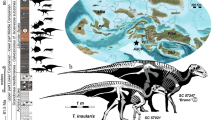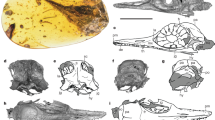Abstract
Sauropod dinosaurs were the largest animals ever to inhabit the land, with truly gigantic forms in at least three lineages1,2,3. Small species with an adult body mass less than five tonnes are very rare4,5, and small sauropod bones generally represent juveniles. Here we describe a new diminutive species of basal macronarian sauropod, Europasaurus holgeri gen. et sp. nov., and on the basis of bone histology we show it to have been a dwarf species. The fossils, including excellent skull material, come from Kimmeridgian marine beds of northern Germany6,7, and record more than 11 individuals of sauropods 1.7 to 6.2 m in total body length. Morphological overlap between partial skeletons and isolated bones links all material to the same new taxon. Cortical histology of femora and tibiae indicates that size differences within the specimens are due to different ontogenetic stages, from juveniles to fully grown individuals. The little dinosaurs must have lived on one of the large islands around the Lower Saxony basin8. Comparison with the long-bone histology of large-bodied sauropods suggests that the island dwarf species evolved through a decrease in growth rate from its larger ancestor.
This is a preview of subscription content, access via your institution
Access options
Subscribe to this journal
Receive 51 print issues and online access
$199.00 per year
only $3.90 per issue
Buy this article
- Purchase on Springer Link
- Instant access to full article PDF
Prices may be subject to local taxes which are calculated during checkout


Similar content being viewed by others
References
Wilson, J. A. Sauropod dinosaur phylogeny: critique and cladistic analysis. Zool. J. Linn. Soc. 136, 217–276 (2002)
Wedel, M. J., Cifelli, R. L. & Sanders, R. K. Sauroposeidon proteles, a new sauropod from the Early Cretaceous of Oklahoma. J. Vertebr. Paleontol. 20, 109–114 (2000)
Smith, J. B. et al. A giant sauropod dinosaur from an Upper Cretaceous mangrove deposit in Egypt. Science 292, 1704–1706 (2001)
Upchurch, P., Barrett, P. M. & Dodson, P. in The Dinosauria 2nd edn (eds Weishampel, D. B., Dodson, P. & Osmólska, H.) 259–322 (Univ. of California Press, Berkeley, 2004)
Rauhut, O. W. M. et al. Discovery of a short-necked sauropod dinosaur from the Late Jurassic period of Patagonia. Nature 435, 670–672 (2005)
Lotze, F. Zum Jura des Langenberges zwischen Oker und Bad Harzburg (nördl. Harzrand). Neues Jb. Geol. Paläont. Mh. 1968, 730–732 (1968)
Pape, H. Die Malmschichtenfolge vom Langenberg bei Oker (nördl. Harzvorland). Mitt. Geol. Inst. Tech. Univ. Hann. 9, 41–134 (1970)
Ziegler, P. A. Geological Atlas of Western and Central Europe 2nd edn (Shell International Petroleum Company, Amsterdam, 1990)
Sander, P. M. Long bone histology of the Tendaguru sauropods: implications for growth and biology. Paleobiology 26, 466–488 (2000)
Horner, J. R., Padian, K. & de Ricqlès, A. Comparative osteohistology of some embryonic and neonatal archosaurs: implications for variable life histories among dinosaurs. Paleobiology 27, 39–58 (2001)
Erickson, G. M. Assessing dinosaur growth patterns: a microscopic revolution. Trends Ecol. Evol. 20, 677–684 (2005)
Chinsamy-Turan, A. The Microstructure of Dinosaur Bone (Johns Hopkins Univ. Press, Baltimore, 2005)
Turvey, S. P., Green, O. R. & Holdaway, R. N. Cortical growth marks reveal extended juvenile development in New Zealand moa. Nature 435, 940–943 (2005)
Nopcsa, F. Über das Vorkommen der Dinosaurier in Siebenbürgen. Verh. Zool. Bot. Ges. Wien 54, 12–14 (1914)
Weishampel, D., Grigorescu, D. & Norman, D. B. The dinosaurs of Transsylvania. Natl Geogr. Res. 7, 196–215 (1991)
Jianu, C. M. & Weishampel, D. B. The smallest of the largest: a new look at possible dwarfing in sauropod dinosaurs. Geol. Mijnbouw 78, 335–343 (1999)
Dalla Vecchia, F. M. et al. Dinosaur track sites in the upper Cenomanian (Late Cretaceous) of the Istrian Peninsula (Croatia). Bol. Soc. Paleont. Ital. 40, 25–53 (2001)
Weishampel, D. B., Norman, D. B. & Grigorescu, D. Telmatosaurus transsylvanicus from the Late Cretaceous of Romania: the most basal hadrosaurid dinosaur. Palaeontology 36, 361–385 (1993)
Le Loeuff, J. Romanian Late Cretaceous dinosaurs: big dwarfs or small giants? Hist. Biol. 17, 15–17 (2005)
Padian, K., de Ricqlès, A. & Horner, J. R. Dinosaurian growth rates and bird origins. Nature 412, 405–408 (2001)
de Ricqlès, A. et al. in BoneVol. 3 Bone Matrix and Bone Specific Products (ed. Hall, B. K.) 1–78 (CRC, Boca Raton, 1991)
Sander, P. M. & Tückmantel, C. Bone lamina thickness, bone apposition rates, and age estimates in sauropod humeri and femora. Paläontol. Z. 76, 161–172 (2003)
Erickson, G. M. et al. Gigantism and comparative life-history parameters of tyrannosaurid dinosaurs. Nature 430, 772–774 (2004)
Sander, P. M. et al. Adaptive radiation in sauropod dinosaurs: bone histology indicates rapid evolution of giant body size through acceleration. Org. Divers. Evol. 4, 165–173 (2004)
Antunes, M. T. & Mateus, O. Dinosaurs of Portugal. C R. Palevol. 2, 77–95 (2003)
Acknowledgements
We thank O. Dülfer, W. Fink, D. Flemming, W. Fricke, A. Hänel, O. Heumann, D. Kranz, M. Lorsch, M. Mastroianni, R. Nimser, G. Oleschinski, U. Resch, D. Rössler, H.-J. Siber, S. Thiele, D. Unwin, F. Wesling, J. Wilson and R. Windolf. We especially appreciate the support of J. McIntosh, F. von Pupka, B. Wolter and H. Lüdtke. This research was supported by the Jurassic Foundation, the Deutsche Forschungsgemeinschaft (DFG) and the Portuguese “Fundação para a Ciência e Tecnologia”. This paper is contribution number 9 of the DFG Research Unit 533 “Biology of the Sauropod Dinosaurs: The Evolution of Gigantism”. Author Contributions P.M.S. was responsible for the bone histology work presented as part of this study. The morphology, systematics and taphonomy of the new sauropod was studied by the remaining authors, who are to be considered the sole authors of the name Europasaurus holgeri gen. et sp. nov.
Author information
Authors and Affiliations
Corresponding authors
Ethics declarations
Competing interests
Reprints and permissions information is available at npg.nature.com/reprintsandpermissions. The authors declare no competing financial interests.
Supplementary information
Supplementary Notes
This file contains information on the geology and taphonomy of the Langenberg quarry locality, details of the phylogenetic analysis including the data matrix, an extended diagnosis of Europasaurus holgeri gen. et sp. nov., information on body length (BL) estimates for Europasaurus and on methods of histologic study of Europasaurus long bones. This file also contains four figures. Supplementary Figure 1 provides a palaeogeographic map of Central Europe during the Kimmeridgian. Supplementary Figure 2 illustrates the various parts of the skeleton, including autapomorphic features. Supplementary Figures 3 illustrates the premaxilla bearing the cranial autapomorphy of Europasaurus. Supplementary Figure 4 illustrates the results of the phylogenetic analysis in a cladogram. (DOC 2708 kb)
*The legend to Supplementary Fig. 2 has been modified on 7 July 2006 by addition of ref. 14 to give due credit for the reconstruction of Brachiosaurus.
Rights and permissions
About this article
Cite this article
Martin Sander, P., Mateus, O., Laven, T. et al. Bone histology indicates insular dwarfism in a new Late Jurassic sauropod dinosaur. Nature 441, 739–741 (2006). https://doi.org/10.1038/nature04633
Received:
Accepted:
Issue Date:
DOI: https://doi.org/10.1038/nature04633
This article is cited by
-
A derived dryolestid mammal indicates possible insular endemism in the Late Jurassic of Germany
The Science of Nature (2021)
-
A reevaluation of the Late Jurassic dinosaur tracksite Barkhausen (Wiehengebirge, Northern Germany)
PalZ (2021)
-
Re-description of the sauropod dinosaur Amanzia (“Ornithopsis/Cetiosauriscus”) greppini n. gen. and other vertebrate remains from the Kimmeridgian (Late Jurassic) Reuchenette Formation of Moutier, Switzerland
Swiss Journal of Geosciences (2020)
-
Bone histology provides insights into the life history mechanisms underlying dwarfing in hipparionins
Scientific Reports (2018)
-
An Improvized Core-Drilling Technique and a New Device for Osteohistology of Fossil Bones: Implementation on a Jurassic Sauropod Dinosaur from India
Journal of the Geological Society of India (2018)
Comments
By submitting a comment you agree to abide by our Terms and Community Guidelines. If you find something abusive or that does not comply with our terms or guidelines please flag it as inappropriate.



